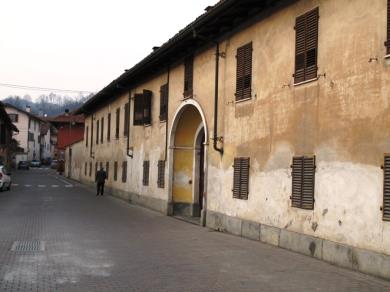Casa Baronale Riccati
La Casa Baronale Riccati appartiene ad una delle famiglie più importanti di Manta già menzionata in carte comunali del 1500.
Tra i più importanti esponenti di questa famiglia ricordiamo Giovanni che lasciò i lavori della campagna per dedicarsi all’industria del ferro e della seta.

All’inizio del 1700 egli dirigeva infatti la fucina e la fonderia del ferro a Paesana, poi a Sampeyre e in altre zone della Valle Varaita. Successivamente costruì a Manta due grandissime filande e ampliò i suoi affari; l’eredità venne raccolta dal figlio Giovanni Pietro che donò anche la casa canonica.
Questo complesso nasce negli anni Novanta del Settecento per ospitare la sola operazione di trattura.
La filanda Riccati conserva ancora inalterate le proprie valenze architettoniche, inglobata entro il palazzo della famiglia patrizia, incarna completamente le caratteristiche dello spazio di lavoro tardo settecentesco.
Il complesso nasce negli anni Novanta del secolo per ospitare la sola operazione di trattura, il cui nucleo centrale, l’imponente tettoia, ricoverava i quaranta fornelletti ”disposti l’uno dopo l’altro” in “una stessa linea retta”, scaldati a fuoco diretto e dotati di altrettanti camini indipendenti.
L’opificio Riccati, continua la sua attività certamente fino agli anni Quaranta dell’Ottocento, manifesta dunque la perfetta adesione formale e funzionale al tipo della “filanda” settecentesca ma vi introduce valenze di grande respiro progettuale che difficilmente si trovano altrove, espresse dal pregevole disegno d’insieme, retto dalla simmetria compositiva dei corpi di fabbrica che si snodano attorno al cortile, a cui si applica un attento e misurato decoro formale offerto dall’apparato decorativo austero, limitato alle specchiature delle paraste che inquadrano le arcate del portico, al gioco delle volte disegnate con lunette ed unghie ed alla strombatura concava del portale esterno.
Si può avanzare l’ipotesi che tanta cura provenisse da un progettista abile, quale in quegli anni era l’architetto Sebastiano Riccati, un membro della famiglia che lavorava per lo più nel torinese, ma che a Manta possedeva terreni ed era presente, negli stessi anni, con pareri ed ispezioni.
E’ proprietà privata pertanto visitabile solo in occasione di alcune manifestazioni.
La Trattatura
La trattura è tra le ultime fasi della bachicoltura ed indica l'insieme di tutte quelle operazioni che servono per ricavare la seta dai bozzoli.
Dopo la raccolta, i bozzoli venivano essiccati, divisi per dimensione, forma e colore e puliti dalla bambagia ed è a questo punto che inizia la trattura, cioè il filo che compone il bozzolo viene dipanato per poter essere lavorato per ottenere il filato di seta.
Un quantitativo di bozzoli, pari allo spessore del filo desiderato, viene immerso in bacinelle piene di acqua caldissima (70°-80°).
L'acqua caldissima ha la funzione di sciogliere la sericina che riveste i bozzoli e rendere più facile la separazione dei capofila. Si strofinano delicatamente i bozzoli con spazzole manuali o meccaniche per catturare i capofila (scopinatura).
I capofila vengono uniti tra loro per avere un filato più robusto perché le bave s'incollano tra loro mediante la sericina. Il filo così ottenuto viene avvolto su un aspo, un perno dal quale si dipartono supporti disposti a raggiera. Il procedimento dura fino allo srotolamento di tutto il filo che contiene il bozzolo (mediamente 1500 metri di bava).
Il filato ricavato dalla trattura è chiamato seta greggia.